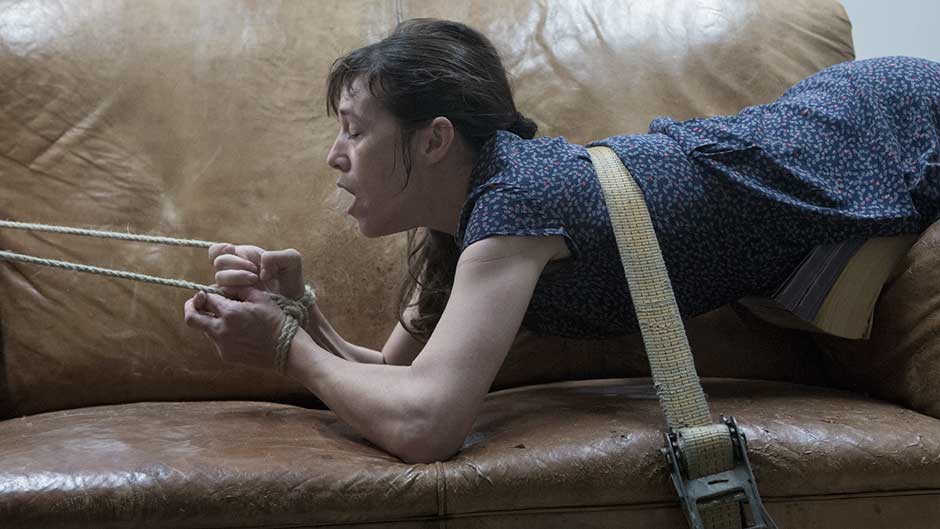The Danish director Lars von Trier has made several great films (Dogville, Melancholia). He has also orchestrated a number of provocations, the strongest of which is The Idiots (1998), a movie that anticipates Borat, Jackass, and other recent movies in pushing regressive behavior beyond all acceptable limits. His newest film, Nymphomaniac, belongs with these audience-baiters—it’s similar, but less ghastly in its various affronts than Antichrist (2009), which also centered on the dour, ascetic Charlotte Gainsbourg.
In Antichrist, Gainsbourg played a woman driven mad by grief; in Nymphomaniac she is the eponymous case study, known simply as Joe. A middle-aged good Samaritan named Seligman (Stellan Skarsgård) finds her lying beaten and bleeding in a back alley and, as she refuses his offer to call the police or get an ambulance, brings her back to recover in his monastic apartment. There she lies on a narrow bed, he sits by her side and, after describing herself as “bad person” (a category that he reflexively rejects), she proceeds to tell him her story from the very beginning: “I discovered my cunt as a two-year-old.”
For a child, as we know, all is sex. Joe’s colorful (if gravely recounted) picaresque career as a sexual being and a sexual adventuress—set in an abstract, unidentified region of England—is punctuated by Seligman’s well-meaning, post-Freudian comments and woolly digressions. Joe’s tale also features a vast array of sex acts, both simulated and actual. (The credits list a half dozen “sex doubles.”) The movie is, then, a two-handed version of the Marquis de Sade’s Philosophy in the Bedroom with Seligman, the erudite lover of the arts and stereotypical liberal—tolerant, secular, feminist, hypocritical—attempting to understand Joe’s self-identified nymphomania as she oscillates between pride and self-loathing and also between present-day battered Joe and her dewy younger self (Stacy Martin).
Like Joe or the sadist she solicits in the movie’s second half, Nymphomaniac is at once excessive and withholding. Although the film is said to exist in a five-and-a-half-hour director’s cut, its distributor has released a shorter “international version” in two parts of 117 and 123 minutes each; the film is further subdivided into eight more-or-less chronological chapters. This two-stage delivery may or may not be a valid economic strategy, but it is a dubious aesthetic one. For what it’s worth, Nymphomaniac demands to be endured in a single sitting. As with Melancholia (2011), which represented the run-up to the end of the world, it’s experiential.
Although too capricious (or should we say promiscuous?) to be a taxonomy, the movie is designed to illustrate and exhaust every popular theory of nymphomania, including, of course, the idea that the condition exists only as a male fantasy—My Secret Garden or The Sexual Life of Catherine M notwithstanding. In various chapters, Joe’s motivations are variously ascribed to her sexual curiosity, desire to exercise traditional male sexual prerogatives, rejection of love, unresolved oedipal feelings, narcissism, loneliness, pathological low self-esteem, depression, frigidity, guilt, and masochism.
At least initially, Joe subscribes to the Sadean notion that she is simply “selfish”—that is, motivated by absolute egotism and a desire for absolute pleasure—although, unlike the Marquis, she does not see this as a virtue. Nor is she bound by logic, explaining at one point that she became a nymphomaniac by choice (“I was an addict of lust rather than need”) and refusing at another, in a memorable set piece, to accept the label “sex addict.”
Von Trier declines to judge his protagonist. Unlike Steve McQueen, whose hellish portrait of a male sex addict was called Shame, or the didactic moralist Michael Haneke (who, in his adaptation of The Piano Teacher, completely missed the comic elements in Elfriede Jelinek’s novel of nymphomaniacal compulsion), von Trier has a sense of humor. However lumpy and tasteless it may be, his gruel is not without its raisins. There is a very funny montage in which young Joe tells a succession of lovers that they have given her her first orgasm; a tumultuous sequence in which an abandoned wife (Uma Thurman), accompanied by her young children, confronts the home-wrecking young Joe, volubly and at great length; a charming religious vision that, among other things, satirizes von Trier’s erstwhile model, Andrei Tarkovsky; and a scurrilously farcical scene in which mature Joe is sandwiched between two squabbling slices of male bread.
Much of the time, however, Nymphomaniac is dogged in its pursuit of what the academic film theorists of the 1970s used to call “unpleasure.” Or at least, that is how it seemed to me. Writing in The New Yorker, David Denby, not hitherto an admirer of von Trier, praised the movie as a “pornographic work of art” which means, I suppose, that it was some sort of turn-on.
Advertisement
Alienation, or the absence of feelings, is for von Trier a source of anxiety. But so is empathy. Antichrist which, above all, strove to make pain visceral, was ultimately only numbing; Grace, the scapegoat protagonist of Dogville (2003), suffered in part because of her generosity: she felt too deeply and wreaked a terrible vengeance as a result. Nymphomaniac’s most graphic sequence is not sexual but rather the miserable circumstances in which Joe’s father, hospitalized, delirious, and incontinent, meets his end. “When he died, I had no feelings left,” she tells Seligman—and not for the last time. The movie’s first part concludes with her loss of sexual sensation. “I can’t feel anything,” she wails after a long, unsatisfying bout of intercourse with her ardent and loving husband (Shia LeBeouf).
Von Trier is frequently accused of abusing his female protagonists. Joe gets more than her share, not least in a particularly graphic form of self-abuse, but essentially von Trier respects her as an enemy of society—her punishment, as well as her philosophy, is really a way of punishing the viewer. Like Alfred Hitchcock, von Trier enjoys directing his audience. He is however far less efficient and far more fretful than Hitch; rather than manipulate viewers he pranks them, as when, in one sequence of Nymphomaniac, he teases fans by threatening to restage a catastrophe out of Antichrist complete with Handel aria.
Despite a common monotony, Nymphomaniac’s two halves are quite different. With one large exception, the first part is consecrated to spectator enjoyment—derived either from the spectacle of the sexual antics involving the beautiful, frequently naked Stacy Martin (a twenty-four-year-old Franco-English actress who has the great good fortune or calamitous luck of making her debut as a featured act in the von Trier circus) or else from the spectacle of Joe successfully defending her erotic rights in a man’s world or, possibly, from both. But the fun is paid for with interest in the movie’s second half by the debasing sexual escapades endured by the more mature and less conventionally appealing Gainsbourg.
Although variously a parody of Freudian analysis or a gloss on the Arabian Nights, Nymphomaniac most closely resembles an eighteenth-century novel about a young woman’s sexually-driven rise and fall or fall and rise; indeed, the first scientific study of female hypersexuality, Nymphomania, or a Dissertation Concerning the Furor Uterinus, was published by a French doctor in the late eighteenth century. Joe, however, is neither De Sade’s oft-violated Justine (for whom the protagonist of Melancholia is named) nor her sister, the sexual terrorist Juliette (although she shares some of her traits). Neither is she Pamela, Clarissa, or Moll Flanders.
In the end, she is the artist. Von Trier is proud of his provocations yet concerned that the audience may too easily indulge him or, pace David Denby, actually become aroused. Indeed, that, in a sense, is the movie’s punchline. Anxious that he will no longer be able to top himself, von Trier is willing to end Nymphomaniac—if not his career—with a cheap stunt meant to rebuke his admirers, as if to prove that he still can.
Nymphomaniac is in theaters now.




